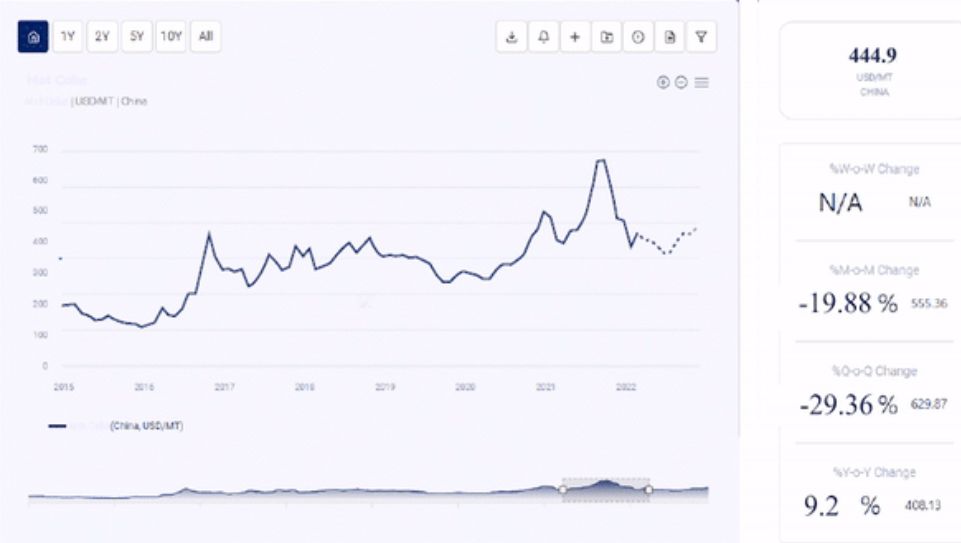Neopentyl Glycol Project Report, Plant Cost | Provided by Procurement Resource
| Report Features | Details |
| Product Name | Neopentyl Glycol |
| Applications | Paints & Coatings, Adhesives & Sealants, Lubricants, Plasticizers, Insulation Materials |
| Supplier Database | BASF SE, Eastman Chemical Company, MITSUBISHI GAS CHEMICAL COMPANY, INC, Wanhua Chemical Group Co., Ltd, OXEA GmbH, TCI Chemicals (India) Pvt. Ltd, LG Chem Ltd |
| Region/Countries Covered |
|
| Customization Scope | The report can be customized as per the requirements of the customer |
| Post-Sale Analyst Support | 360-degree analyst support after report delivery |
Request for Real Time Neopentyl Glycol Prices: https://www.procurementresource.com/resource-center/neopentyl-glycol-price-trends/pricerequest
Neopentyl glycol is an organic chemical compound also known as 2,2-dimetnylpropane-1,3-diol. When utilised in the manufacturing process, neopentyl glycol increases the polyester product's resistance to heat, light, and water. Neopentyl glycol has a molecular weight of 104.148 g/mol.
By esterifying fatty or carboxylic acids, it is possible to produce synthetic lubricating esters with lower oxidation or hydrolysis potential than natural esters. In the Aldo process, two carbonyl compounds are mixed to create Aldol, which is then used to manufacture neopentyl glycol on a massive scale. This produces the intermediate hydroxypivaldehyde, which can then be processed by either a palladium on carbon hydrogenation procedure or a Cannizzaro reaction with formaldehyde to produce neopentyl glycol.
The nations that produce neopentyl glycol are South Korea, Japan, the US, Brazil, and Sweden.
Key Details About the Neopentyl Glycol Price Trend:
Procurement Resource does an in-depth analysis of the price trend to bring forth the monthly, quarterly, half-yearly, and yearly information on the neopentyl glycol price, tin plate price and dihydro myrcenol price etc. in its latest pricing dashboard. The detailed assessment deeply explores the facts about the product, price change over the weeks, months, and years, key players, industrial uses, and drivers propelling the market and price trends.
Each price record is linked to an easy-to-use graphing device dated back to 2014, which offers a series of functionalities; customization of price currencies and units and downloading of price information as excel files that can be used offline.
The neopentyl glycol price trend, pricing database, and analysis can prove valuable for procurement managers, directors, and decision-makers to build up their strongly backed-up strategic insights to attain progress and profitability in the business.
Industrial Uses Impacting Neopentyl Glycol Price Trend:

Because it improves the product's durability toward water, light, and heat, neopentyl glycol is used in a variety of industrial applications, including the creation of polyesters. Additionally, it is also used in lubricants, insulation, paints, and other products.
Key Market Players:
• BASF SE
• Eastman Chemical Company
• MITSUBISHI GAS CHEMICAL COMPANY, INC.
• Wanhua Chemical Group Co., Ltd.
• OXEA GmbH
• TCI Chemicals (India) Pvt. Ltd.
• LG Chem Ltd.
News and Events:
• October 01, 2021: For the first time, BASF is offering neopentyl glycol (NPG) and propionic acid (PA) with a cradle-to-gate product carbon footprint (PCF1) of zero2. The goods are created in BASF's Ludwigshafen Verbund factory in Germany and sold under the names "NPG ZeroPCF" and "PA ZeroPCF." BASF achieves zero PCF for NPG and PA by utilising renewable raw materials in its proprietary Verbund production system and applying the biomass balance (BMB) technique. In addition, BASF produces NPG with the help of renewable energy.
Related Reports:
- Natural Rubber Prices - https://www.procurementresource.com/resource-center/natural-rubber-price-trends
- Hydrogen Cyanide Price Chart - https://www.procurementresource.com/resource-center/hydrogen-cyanide-price-trends
- Rifampicin Price Index - https://www.procurementresource.com/resource-center/rifampicin-price-trends
About Us:
Procurement Resource offers in-depth research on product pricing and market insights for more than 500 chemicals, commodities, and utilities updated daily, weekly, monthly, and annually. It is a cost-effective, one-stop solution for all your market research requirements, irrespective of which part of the value chain you represent.
We have a team of highly experienced analysts who perform comprehensive research to deliver our clients the newest and most up-to-date market reports, cost models, price analysis, benchmarking, and category insights, which help in streamlining the procurement process for our clientele. Our team track the prices and production costs of a wide variety of goods and commodities, hence, providing you with the latest and consistent data.
To get real-time facts and insights to help our customers, we work with a varied range of procurement teams across industries. At Procurement Resource, we support our clients, with up-to-date and pioneering practices in the industry, to understand procurement methods, supply chain, and industry trends, so that they can build strategies to achieve maximum growth.
Contact Us:
Company Name: Procurement Resource
Contact Person: Chris Byrd
Email: sales@procurementresource.com
Toll Free Number: USA & Canada - Phone no: +1 307 363 1045 | UK - Phone no: +44 7537 132103 | Asia-Pacific (APAC) - Phone no: +91 1203185500
Address: 30 North Gould Street, Sheridan, WY 82801, USA


Comments
Post a Comment